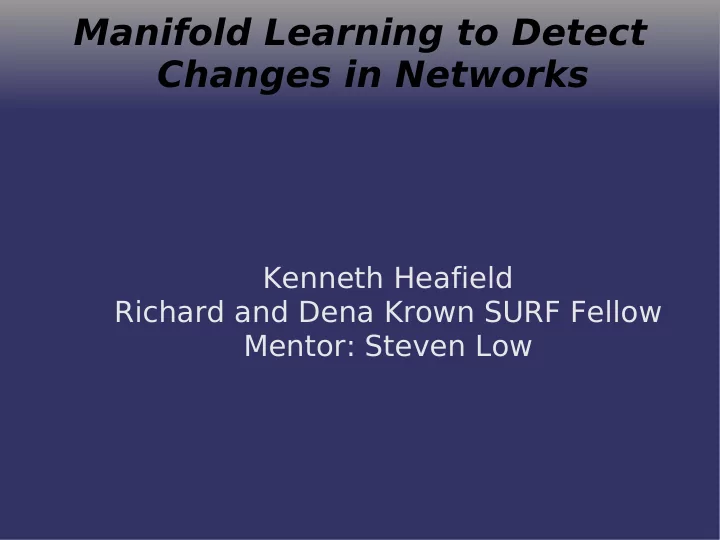

Manifold Learning to Detect Changes in Networks Kenneth Heafield Richard and Dena Krown SURF Fellow Mentor: Steven Low
Problem ➲ Monitor systems and watch for changes ➲ Unsupervised ● Computer must be able to learn patterns ● Automatically determine if deviation is significant ➲ Fast ● Test for anomalies as data comes in ● Incorporate new data into model ➲ Non-linear ● Algorithm needs to work in many envi- ronments
Applications to Networking ➲ Monitor network packets and streams ● Collect header information, particularly port numbers ➲ Security ● Detect worms by large, structural changes ● Detect viruses by small numbers of devia- tions from fit ➲ Optimization ● Automatically learn traffic patterns and react to them ● Anticipate traffic
Outline ➲ How to phrase the problem mathemat- ically ➲ Linear regression in multiple dimen- sions with Principal Component Analy- sis (PCA) ➲ Extending PCA to estimate errors in principal components ● How to use the errors ➲ Kernel PCA adds non-linearity ➲ Future ● Implementation
Thinking Geometrically ➲ Each packet is a data point with coor- dinates equal to its information ➲ Fit a manifold to find patterns ● Compare with previous fits by storing manifold parameters ● Structure of manifold can tell us about un- derlying processes ➲ Distance from manifold indicates de- viation
Principal Component Analysis ➲ Choose directions of greatest variance ● These are the eigenvectors of the covari- ance matrix ● Called Principal Components ➲ Widespread use in science ➲ Linear ● Many non-linear extensions—we will focus on kernel PCA later ● Equivalent to least-squares ➲ Jolliffe 2002
Error Finding ➲ Goal: Find errors in Principal Compo- nents. ● Assume uncorrelated, multivariate normal distribution ➲ Find out how much each component contributes to estimating each point ➲ Get error of estimate in terms of (un- known) errors in components. ● Use residual to approximate error ➲ Out pops a regression problem which we can solve
Finding the Nearest Point ➲ Principal Component Analysis defines a subspace ● Example: Linear regression finds a one- dimensional subspace of the two-dimen- sional input ● Components are orthonormal ➲ Project data point into subspace ● Data point X i ● Components C k m ● Nearest point N i = ∑ X i ⋅ C k C k k = 1
Error in Nearest Point ➲ is the closest point to data N i X i ● Residual is X i − N i ➲ What is the error in this estimate? ● Predictor variance i 2 N i ● Component variance k 2 C k ● Symmetric about component, spread evenly in the possible dimensions p − 1 ● Propagate the error: m 1 p − 1 ∑ i 2 = k 2 X i ⋅ X i − 2 X i ⋅ N i p X i ⋅ C k 2 k = 1
Idea: Regression Problem 2 ∥ X i − N i ∥ ➲ Use squared residual length ● This should, on average, equal predictor 2 variance i ➲ Goal: Find k ● This is a linear regression problem: m 1 p − 1 ∑ ∥ X i − N i ∥ 2 ≈ k 2 X i ⋅ X i − 2 X i ⋅ N i p X i ⋅ C k 2 k = 1 ● Subject to constraints 2 1 To be a variance, 0 k ●
What All That Math Just Meant ➲ We did linear regression in multiple dimensions ➲ Found the point closest to each data point ➲ The residuals estimate error present ➲ Error is allocated to the contributing components
Using the Errors ➲ Recall assumptions about error ➲ Compare time slices to find structural changes ● Match up components then test for similar- ity ➲ Measure distances to anomalous points ● We can find the standard deviation at any point on the manifold ● Compare residual to standard deviation and test
Kernel Principal Component Analysis ➲ Non-linear manifold fitting algorithm ➲ Conceptually uses Principal Compo- nent Analysis (PCA) as a subroutine ● Non-linearly maps data points (linearizes) into an abstract feature space ● Performs PCA in feature space ➲ Errors ● Error computation is conceptually the same ➲ Schölkopf et al. 1996
Kernels ➲ Feature space can be high or even in- finite dimensional ● Avoid computing in feature space ➲ Map two points into feature space and compute dot product simultaneously ● Kernel function takes two data points and computes their dot products in feature space Non-data points are expressed as linear combi- ● nations ● Example: polynomials of degree d k x , y = x ⋅ y 1 d
Future ➲ Implementation ● Working kernel PCA implementation ● Hungarian algorithm for matching compo- nents ● Use constrained least-squares regression algorithm ➲ Use ● Time slice incoming network data ● Compare fits between slices ● Classify regions of manifold as potential problems
Summary ➲ Problem arising from computer net- works ➲ Application of Principal Component Analysis (PCA) ➲ Extensions to PCA ● Accounting for and using error ● Kernel PCA ➲ Future of project
Acknowledgements ➲ Richard and Dena Krown SURF Fellow ➲ SURF Office
Recommend
More recommend